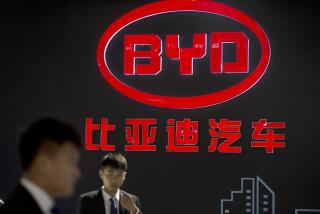NEWS ANALYSIS : U.S., Japan May Be Changing Places in Autos : Vehicles: The seemingly invincible Japanese have financial problems. American firms have become more competitive and are returning to profitability.
- Share via
DETROIT — As the heads of the Big Three U.S. auto firms visited Japan with President Bush in January to ask for trade relief, Ford Motor Co. was quietly preparing a relief package of sorts for its Japanese partner, Mazda Motor Corp.
The resulting deal--Ford’s agreement to buy half of Mazda’s U.S. assembly plant for hundreds of millions of dollars--provided Mazda with a cash infusion at a time when capital is getting scarce and costly in Japan, and such lenders as Sumitomo Bank Ltd., owner of 5% of Mazda, are themselves hurting.
“At the same time we were hearing that Japan held all the cards, Mazda was begging Ford for cash. That’s the great irony of the trip to Japan,” says Paul Willen, a research associate at the Economic Strategy Institute in Washington.
The striking role reversal illustrates a major change taking place in the outlooks and strategies of U.S. and Japanese auto firms. The seemingly invincible Japanese are having financial woes. The still-beleaguered U.S. industry is becoming more competitive and returning to profitability. General Motors Corp. reported a $179-million first-quarter profit on Tuesday, while Ford reported a $338-million first-quarter profit on Wednesday. And Western nations have served notice that made-in-Japan vehicles are welcome only up to a point.
This confluence of events is already reverberating through the U.S. car market:
* Generous U.S. price hikes that Japanese auto firms imposed the past two months have widened a price advantage that Detroit already held in many key vehicle lines. Although the hikes were thought to be political, analysts say it is now clear that the Japanese need the money.
* Japan’s politically driven new ceiling on auto exports to this country--to approximately 1991’s level of 1.68 million cars--limits Japanese auto firms’ ability to keep pace with the expected recovery in U.S. auto sales or to use exports to bolster the Japanese economy.
* Troubles back home, including declining domestic sales and profits and an end of Japan’s accustomed low-cost capital, have prompted Japanese auto firms to slash capital spending 12% and slow their breakneck cycle of new-car introductions. At the same time, U.S. competitors are spending heavily to launch a steady flow of new products.
Most of the price hikes are taking effect as vehicles reach this country, and April sales to be reported next week will offer the first good look at any competitive losses the Japanese are incurring as a result, analysts say. But all the Japanese firms except Toyota lost market share in the first quarter.
In the longer term, the profit squeeze, a less-aggressive approach to new-car development and the virtual disappearance of Japan’s cost-of-capital advantage over U.S. industry are seen as changing the dynamics of the world auto industry.
U.S. observers say it could finally spread the ongoing global automotive shakeout to Japan’s auto firms, give both U.S. and European car firms more breathing room and chip away at Japan’s advantages.
“Japan’s domestic recession and volatile capital markets have a long-term positive implication for the U.S. auto companies,” says Douglas Laughlin, who follows the auto industry for Bear Stearns & Co. in New York.
Despite the salutary shifts and this week’s announcements of a rapid return to profitability at Ford Motor Co. and General Motors Corp., U.S. auto executives insist that there are no celebrations going on.
“They could come after us even more than before,” muses David McCammon, treasurer and finance vice president at Ford. “There are pluses and minuses.”
Indeed, analysts say that the last time Japan’s auto industry was threatened by wrong-way economics--when the value of the yen against the dollar doubled between 1985 and 1987--it served to galvanize auto makers and Japan’s government.
Moreover, Japan’s top three makers will soon be able to boost their U.S. production significantly to meet any rising demand. Nissan and Toyota are each doubling their U.S. capacity by 200,000 vehicles, Nissan as of this summer and Toyota by 1994. And Honda has unused capacity of 50,000 vehicles in East Liberty, Ohio.
Given Japan’s “resiliency and ability to pull together in time of crisis,” analyst Maryann Keller of Furman Selz Inc. in New York figures that the U.S. auto industry has only “the next year or so” to exploit the weaknesses of its foreign competitors.
Moreover, Detroit’s critics contend that its track record in making good use of breathing room--as in the mid-1980s, when the U.S. industry was faulted for jacking up car prices along with the Japanese and using the money to make bad investments--is mixed at best.
“The question is, given all this breathing room, how intelligently will the Big Three use it?” asks analyst David Garrity of McDonald & Co.
But analyst Willen, whose economic think tank has supported the U.S. industry’s position on trade and economic policy issues, contends that Detroit’s spending on efficiency and productivity in the 1980s undercuts such charges and has made the U.S. industry virtually as efficient as Japan’s.
“The U.S. industry has made such tremendous progress that it may not need any excuses,” Willen says.
In any event, Keller and other U.S. observers view the Japanese auto firms’ problems as significant.
“The question that now confronts us is whether the Japanese auto industry can make a transition into a tougher world, one where the financial playing field is more level than it ever has been and one characterized by little or no growth,” Keller says.






